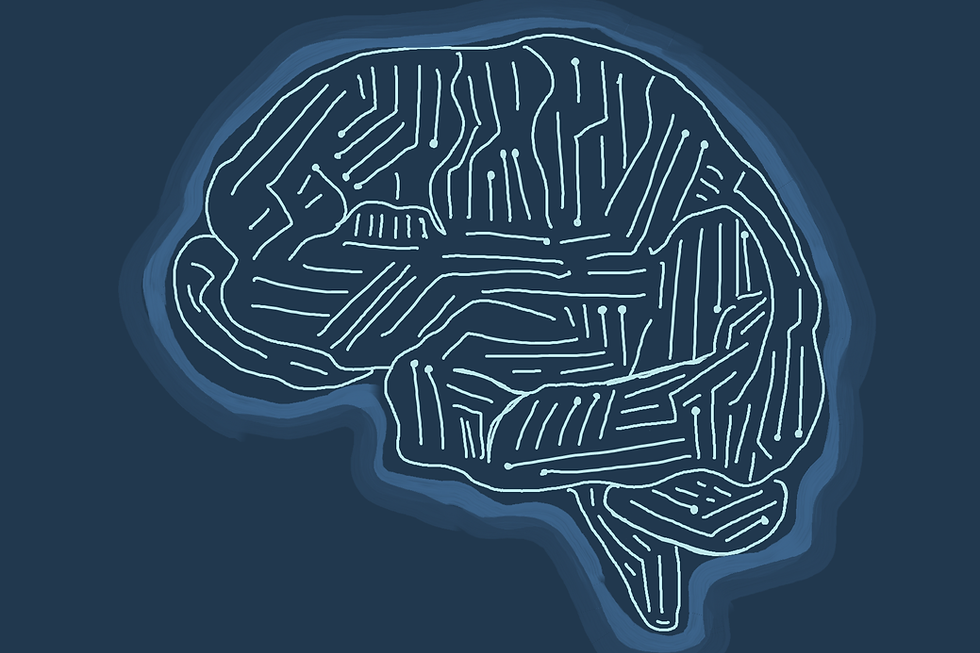Supernormal Neural Networks
- The Natural Philosopher
- Apr 11, 2022
- 2 min read

By Conor Doolin
The brain is an extremely complex system that can perform a huge variety of tasks. Deep learning systems use data and algorithms to train artificial intelligence (AI) machines. Artificial intelligence is inspired by the creative arrangements of human consciousness. The main difference between AI and human intelligence is that humans rely on past mistakes or gained knowledge to perform tasks while AI machines depend on complex input data [1].
AI machines shape a future of automated tasks, economic growth, creativity, and innovation. These tasks can translate to financial estimates, automated driving, smart home security, and clinical healthcare decision systems [2]. In the healthcare sector, AI falls into two main categories: supervised and unsupervised [2]. Supervised methods include labeled data, which acts as raw data input for machine learning systems, such as X-ray detection tracers, implantable cardiac device feedback interpretation, and prognosis models of infectious diseases [2]. Unsupervised learning models work to solve more complex problems such as hidden patterns. These patterns could contribute to pharmacogenomics, a branch of genetics concerned with individuals’ genetic attribution to therapeutic drugs. Also, reinforced learning, a deep learning system training method based on validating desired outcomes and/or highlighting undesired ones, could maximize the accuracy of disease prediction and treatment outcomes. Precision health, drug discovery, repurposing, and epidemic outbreak prediction models could become more accurate and precise with the support of deep learning machines [2].
Unfortunately, there are many challenges and alternative perspectives that prevent forward progress in technological personalized medicine [2]. First, there are computational challenges associated with algorithms capable of improving positive patient health care efficacy. Algorithms cannot encompass suitable predictions for all genetic diversity across human populations, so data and insight need to form continuous evolving arrays of questions [2]. Secondly, the volume becomes an issue with safe, applicable AI healthcare decision systems. The scale of data inputs and outputs presents challenges with clusters of CPUs data sharing between the cloud and performing deep-learning executions instantaneously [2]. Lastly, ethics presents a huge debate as data privacy is defined as a fundamental human right [2]. This protection of privacy must be balanced with the potential ability of health care institutions to improve patient care by communicating data with other practitioners or patients. Moreover, a convergence of medical technologies and a centralized electronic medical record can improve AI deep learning system algorithms ultimately revolutionizing patient care and accessibility to the complexities of data insight. In the end, it may be humanitarian to further develop the theories and algorithms of AI and substitute human tasks with deep human-machine learning integration.
Works Cited:
[1] M. Ergen, “What is Artificial Intelligence? Technical Considerations and Future Perception,” Anatol. J. Cardiol., 2019, doi: 10.14744/AnatolJCardiol.2019.79091.
[2] N. Noorbakhsh-Sabet, R. Zand, Y. Zhang, and V. Abedi, “Artificial Intelligence Transforms the Future of Health Care,” Am. J. Med., vol. 132, no. 7, pp. 795–801, Jul. 2019, doi: 10.1016/j.amjmed.2019.01.017.



z8bet.ws – Trang chủ chính thức nhà cái uy tín hàng đầu Châu Á. Truy cập link mới nhất, đăng nhập nhanh, tải app và nhận ưu đãi hấp dẫn.
Been grinding Capybara Clicker Official. It’s oddly relaxing and satisfying. http://capybaraclicker.net/
Been grinding Capybara Clicker Official. It’s oddly relaxing and satisfying. http://capybaraclicker.net/
acc liên quân nơi bạn dễ dàng sở hữu nick chất, skin hiếm với giá hợp lý. Giao dịch nhanh chóng, bảo mật an toàn, hỗ trợ tận tình 24/7!
net88 là nhà cái cá cược uy tín, cung cấp đa dạng game như thể thao, casino, game bài, lô đề… Giao diện hiện đại, dễ chơi, trải nghiệm hấp dẫn.